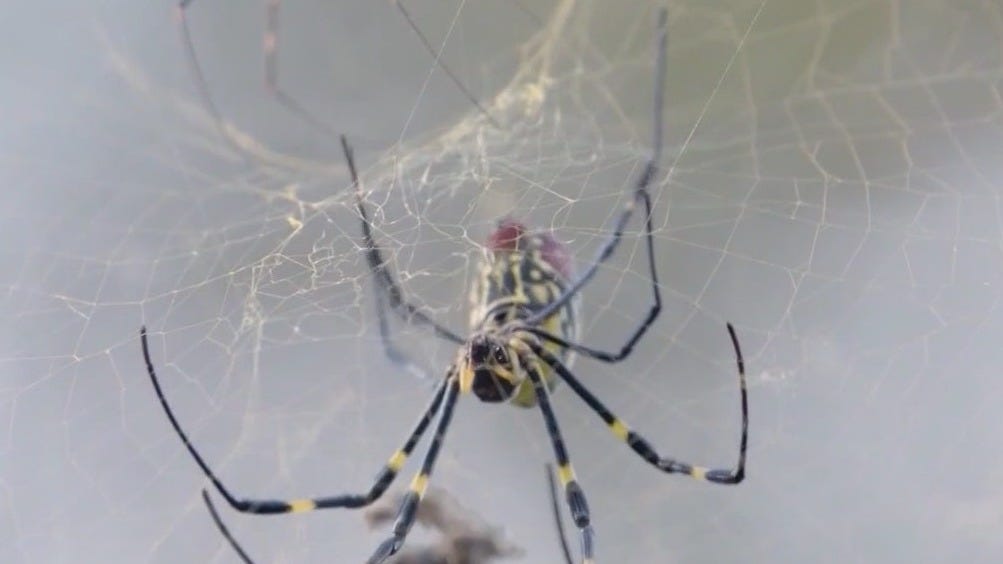Description

Have you heard yet about the giant, venomous flying spider that could potentially invade the East Coast this year?
The Joro spider, native to Japan, has put New York and New Jersey on high alert with experts warning the spiders are likely to move into those states sometime this year.
José R. Ramírez-Garofalo, an ecologist at Rutgers University's Lockwood Lab, told the Staten Island Advance in April that "it is a matter of when, (and) not if" the spiders make their way to New York and New Jersey.
Which begs the question, will these arachnids, which were first spotted in the U.S. 10 years ago, make their way to New England any time soon?
As of right now, they're not considered a threat, according to Professor Laura A. Meyerson, who teaches courses on invasion science, restoration ecology and conservation biology and is the Director of both the Restoration Ecology and Environmental Science minors at the University of Rhode Island (URI).
"They are for sure spreading, including into TN and Baltimore, MD, but there have been no reports in Rhode Island or anywhere in New England," Meyerson said. "They are cold-tolerant, so it is possible that they could arrive here and survive. But at this point, it is really not known."
The theory behind the Joro spider's origin in the U.S. is that the venomous arachnids were unintentionally transported by way of cargo shipments, international trade and personal travel.
"It is thought that they were most likely introduced from Asia in cargo," Meyerson said. "They are good stowaways. They are likely moving to new areas in the U.S. both by ballooning (flying) and also being carried in cargo and as stowaways by people who are unaware that they are there."
She said it is possible they arrived earlier than 2014 and went undetected for several years.
"This is a shy spider," Meyerson said. "However, unlike many other spiders, this species does well in busy areas such as urban areas and around roads."
The Joro spider's ability to adapt to various environments and to reproduce rapidly has helped them continue to establish themselves.
“This spider is going to be able to inhabit most of the eastern U.S.,” David Coyle, invasive species expert at the University of Clemson, said in October 2023 to USA Today. “It shows that their comfort area in their native range matches up very well with much of North America ... Barring some unforeseen circumstance, we expect the range of these things to continue expanding, likely to the north, and we’ve already seen that with some populations in Maryland."
The spiders are hard to miss.
The Joro spiders are known for their distinctive yellow bands on their black legs. The males have a light brown abdomen, while the females have bright yellow abdomens with blue-gray bands.
In addition to the bright yellow marking, they're large.
The females can be 6 to 8 inches large which fully stretched out, and are double the size of males.
While Joro spiders are venomous, they're not considered a threat to humans.
"One thing to note is that most spiders are venomous but most are not considered dangerous to humans," Myerson said. "The Jorō is venomous, but its fangs are not designed to pierce human skin. There have been a few reports of people being bitten but none seriously harmed. Still, it's a good idea to avoid handling them."
Their bite can caused an allergic reaction.
Massachusetts DPH spokesperson Omar Cabrera told USA Today that, "this is not a public health issue. As is true with many spiders, they use venom to kill their food items (other insects) but it does not pose a risk to humans."
Joro spider don't have wings. But they do have a talent for sailing on wind currents.
"However, there will not be hand-sized Jorō spiders raining down from the sky, it is primarily the small light-weight spiderlings that transport this way," Myerson said.
When the spiders hatch in the spring and early summer, the small spiders create a balloon of silk to travel on. It's not an uncommon trait for web spiders, but Joro spiders make their leap from an elevated spot and if they catch the right wind are capable of moving more than 100 miles.
That is also why they can spread so far.
There are not any definitive ways to get rid of them.
But Meyerson explained that you probably won't have to.
"Good news - they are not house spiders, though they may build webs on your porch or deck or lawn furniture," she said. "However, they are attracted by light so keeping outdoor lights off at night will help and will also benefit other nocturnal wildlife such as fireflies, moths, bats, and other species."
Other Related News
07/26/2024
Marilyn Monroe famously told the world that diamonds are a girls best friendA Plymouth man...
07/26/2024
MARSHFIELD Mere weeks before the start of the COVID-19 pandemic in March 2020 Henry Pham ...
07/26/2024













